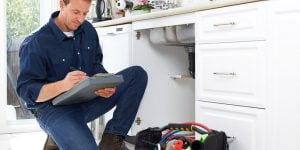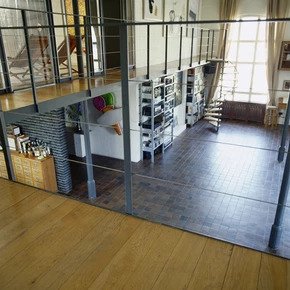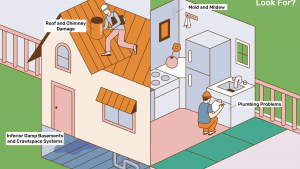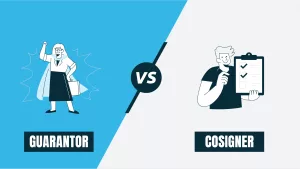The final home walkthrough checklist in NYC (2018)
August 17, 2018 by Georges Benoliel
Go Back To Previous Page
 You finally made it and can see the end in sight. You are hours away from getting the keys to your new place. The final home walkthrough in NYC is one of the last steps in the purchase process, and it serves as the final inspection before changing ownership. It is never a good idea to blow off the final Walkthrough. In this post, we will provide you with a comprehensive final home walkthrough checklist.
You finally made it and can see the end in sight. You are hours away from getting the keys to your new place. The final home walkthrough in NYC is one of the last steps in the purchase process, and it serves as the final inspection before changing ownership. It is never a good idea to blow off the final Walkthrough. In this post, we will provide you with a comprehensive final home walkthrough checklist.
The final Walkthrough remains the last step before closing. We’ll explain the purpose of a final walkthrough and provide you with a handy checklist for your final home walkthrough. We will also explain the differences between a final walkthrough for a resale property and a new construction project.
The final walkthrough is vital in the home-buying process just before closing. This is the buyer’s opportunity to confirm that the property is in the condition agreed upon in the contract and that any promised repairs or changes by the seller have been completed. Here’s a detailed overview of what the final walkthrough entails and what buyers should pay attention to:
Final Walkthrough Purpose
1. Verification of Condition
During the final walkthrough, you will check that the property is in the same condition as when the offer was made. You will also verify that the seller has completed the agreed-upon repairs and ensure that no new issues have arisen since the home inspection.
2. Check for Inclusions
One crucial aspect of the final walkthrough is verifying that all items included in the sale, such as appliances and fixtures, are still present and in working condition. Additionally, ensure that the property is clean and free of the seller’s personal belongings unless otherwise agreed upon.
What Is the Final Home Walkthrough?
It is the final inspection of the property by the buyer and their broker before closing. Brokers usually schedule the Walkthrough the day before closing, but sometimes, it takes place on the very day of the closing.
Lastly, the buyer and seller’s real estate agents attend with the buyer.
When to Do the Final Walkthrough?
The ideal time to conduct a final walkthrough is 24-48 hours prior to the closing date. This timing allows enough leeway to address any last-minute issues without delaying the closing. Here’s a final walkthrough checklist so you know what to look for:
What to look for during the final home walkthrough in NYC
A general home final walkthrough checklist to follow is as follows.
- Any repairs are promised to be completed.
- Contractually agreed items are in place.
- All light fixtures work.
- Appliances are in working order
- The bathroom operates properly
- Laundry machines run accordingly.
- Walls and floors are not damaged
- There is no evident sign of pests
- Could you confirm that all major appliances are still present and in working order?
- Turn the stove and stovetop burners on and off. Remember to turn off the gas.
- Could you check the temperature of the interior of the refrigerator and freezer?
- Test all lights and dimmer switches
- Run the dishwasher, and remember to end the cycle before you leave.
- Could you test the washer and dryer?
- Test all doors and door handles, including closet doors and exterior doors.
- Open and close all windows.
- Check for new scratches and scuff marks on walls, floors, and the ceiling.
- Test all electrical outlets with your smartphone charger.
- Test all faucets, flush the toilet, run the shower, and check for leaks.
- Could you please verify that the heating and air conditioning units are functioning correctly?
- Could you test the intercom, door buzzer, or virtual doorman system?
- Test smart home features and control panels.
Although the walkthrough is typically a formality, significant issues can sometimes arise.
For example, the unit may be dirty or not equipped; the seller may still need to complete the negotiated repair.
With the above checklist, you are all set for the final home walkthrough.
 There are several solutions to fix any of these issues.
There are several solutions to fix any of these issues.
There is no one-size-fits-all answer.
The first obvious response is to delay closing. We suggest avoiding this option, as it can cause significant damage if there is a lender, and time is of the essence regarding loan specifications. We only keep that option for irresolvable situations.
However, the right solution is for the seller to provide concessions. Therefore, concessions remain economical or provide specific repairs/work in the apartment. These will satisfy the buyer and ensure the closing process is completed as scheduled.
Another good alternative is to hold proceeds in escrow, and the seller will get access to them after completing the necessary work and satisfying the buyer.
There are as many solutions as problems. It would be best to have a broker looking after your interests in a transaction. Your broker at Nestapple will always be with you during this final inspection.
Final Walkthrough for New Construction
This final Walkthrough is different for new constructions. In new buildings, we recommend two walk-throughs. The first is to devise a “punch list” before contract execution, and the final home Walkthrough ensures that everything on the “punch list” is completed.
“punch list” before contract execution, and the final home Walkthrough ensures that everything on the “punch list” is completed.
What is a Punch List
A punch list is a list of items that the buyer wants the sponsor to fix before closing. Sometimes, building new construction takes so long that the sponsor repairs items after closing. Therefore, punch lists sometimes need to be completed during the closing process.
Sponsors strive to complete the construction punch list items after closing.
There is no standard timeline for completing the punch list; sponsors must make commercially reasonable efforts to meet it.
The more prominent sponsors have a reputation for protecting and doing an excellent job with punch lists.
Final Home Walkthrough for Re-Sale
Typically, a property in New York is sold as-is, and the seller will not agree to make any repairs or changes. The only time a seller might decide to make repairs is if the buyer is the only interested party. Therefore, the seller is desperate because the property has been on the market for an extended period.
repairs is if the buyer is the only interested party. Therefore, the seller is desperate because the property has been on the market for an extended period.
Even then, buyers and sellers in New York usually agree on a “closing credit.”
This is a seller concession in the form of closing costs or a sale price reduction, rather than requiring the seller to make repairs to the apartment.
Who Attends a Final Walkthrough?
The buyer, the buyer’s agent, and any family members or other individuals moving into the home typically attend the final walkthrough before closing. The seller or the seller’s agent will be present during this walkthrough, as their presence may put pressure on them.
They should have the opportunity to thoroughly inspect the property for any potential issues without feeling rushed or influenced by the seller.
You can address any problems discovered during the walkthrough with the seller or the seller’s agent before the final closing. Uncommon for the buyer.
How Long Does a Final Walkthrough Take?
The duration of the property inspection is at the buyer’s discretion. If the initial inspection showed only minor issues, the buyer may need 15 to 30 minutes to verify that no new problems have arisen. However, the inspection could take several hours for larger properties or if significant issues were discovered that require repairs.
If serious issues are found during the final walkthrough, the closing may need to be postponed until those issues are resolved. In such cases, a second final walkthrough may be necessary to confirm that the problems have been resolved.
What to Do if You Find Issues During the Final Home Walkthrough?
If you discover any new issues during the final walkthrough before closing, you must bring them to the seller’s or agent’s attention to find a solution. You might mentally note minor issues and handle the repairs yourself, as addressing them could jeopardize the deal.
However, if the problems are more significant, you can ask the seller to make the necessary repairs or request a credit to cover the repairs yourself.
In this case, you may need to reschedule the closing to ensure the repairs are completed before you sign the contract.
Bottom line: Final Home Walkthrough Is Not a Home Inspection
During the final home Walkthrough, the buyer ensures they receive what they negotiated and agreed upon in the contract. This differs from the home inspection performed before the purchase.
We recommend that every buyer conduct a home inspection after the accepted offer but before executing the purchase contract. This will give the buyer maximum leverage in the contract negotiation. As we detailed in another post about home inspections, buyers can use this opportunity to identify issues with the apartment and request that the seller address them.
Alternatively, buyers can negotiate a seller’s credit (or a purchase price reduction). When the property is sold as-is, and the seller refuses to make the repairs, the buyer and seller usually agree to a price reduction.
In our case, buyers must treat the final home Walkthrough differently from a home inspection.
The goal is not to identify issues that should have been addressed before the contract signing. Therefore, the goal is to confirm that the property has remained unchanged since then. The majority of contracts specify that the property is sold “as-is.”
This means the condition was found on the date of execution. The appliances remain in working order and are specified. Contracts also specify any negotiated inclusions and exclusions when you buy a home.



 “punch list” before contract execution, and the final home Walkthrough ensures that everything on the “punch list” is completed.
“punch list” before contract execution, and the final home Walkthrough ensures that everything on the “punch list” is completed. repairs is if the buyer is the only interested party. Therefore, the seller is desperate because the property has been on the market for an extended period.
repairs is if the buyer is the only interested party. Therefore, the seller is desperate because the property has been on the market for an extended period.

